Guitar chords
Guitar Chord is the site for anyone who wants to learn guitar chords or wishes to discover new ones. You will find diagrams and the chords are put in context with chord progressions so you can instantly begin to practice. All the theoretical substance has been minimized, and you are given straightforward facts that help you to get into guitar playing right away.
Beginner chords

Open chords

Power chords

Major chords

Minor chords

Latest content
Guide: Start playing chords
Beginner: The easiest guitar chords
Intermediate: Chord progressions in famous songs
Advanced: Tritone substitution progressions
New lessons: Intermediate chord progressions – lesson 8
New article: Guide tones
New guide: Chords in standard notation
New tool: Chord progressions generator
Free ebooks: The Chord Training ebook
| The Power Chords ebook
New video
See more videos from Guitar-Chord.org
What is a guitar chord?
Guitar chords are groups of notes and these deliver harmony when played together. They can be used for everything from one-chord grooves to long progressions with key changes. Let’s look at the C major chord, which includes the notes C, E and G.
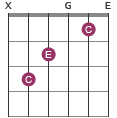
C Major chord
In this specific C chord (a chord can be played in many ways), there are five notes played together: C, E, G (open string), C and E (open string). We sometimes play the same note twice but in different octaves to get a richer sound.
A common way to separate guitar chords is in major and minor. There is a difference in sound between these: the major tends to sound cheerful or neutral whereas the minor has more of a sad character. Because of this, you hear more major chords in fast rock songs and lots of minor chords in ballads.
To achieve new tone colors, additional notes can be added. As in this guitar chord:
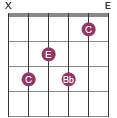
C7 chord
The name of this chord is C7 and if you hear some blues in it, you’re completely on the spot – these kinds of chords are regularly used in the style of the blues. C7 also represents a third chord category: dominant chords. These add tension to a chord sequence. When the letter is followed by a number, but without the "maj" or "m "abbreviations, it's often a dominant chord.
The C7 chord consists of the notes C, E, Bb, C and E. As you may have noticed, we no longer have a G note. Due to the construction of the guitar we sometimes have to skip some less important notes in a chord. The fifth note is the note that is commonly skipped in these cases. (Even on the piano, when things like this aren't forced, notes are sometimes left out because there would otherwise be too many harmonic notes together with additional melody notes.)
For the C chord, a B note can be added to create another flavor and that chord is called Cmaj7 (‘maj’ stands for major).
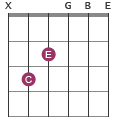
Cmaj7 chord
By releasing the second string (B-string) we have got – as the picture above shows – the following notes: C, E, G, B and C. Cmaj7 could be considered as richer in sound than the ordinary C major. There are the same numbers of tones, but fewer duplicate tones in Cmaj7 (one) compared to C major (two).
This group of chords is used in many music styles, but perhaps you associate the sound to melancholy ballads?
If we add the note D to the Cmaj7 chord we get yet another flavour:
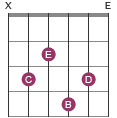
Cmaj9 chord
The major 9th is for example used in jazz.
There are lots of them; all you really need to do is place your fingers in a random position on the fretboard and you accomplish a guitar chord. But it's not until you do it with control and in organized form that music is created. The guitar chords are categorized in names (e.g. C, C7) and bigger groups. There are also different types of chords and some of the more common ones are defined as follows:
On this site you also find sus chords, slash chords and many other categories.
Sharps (#) and flats (b)
One thing to be familiar with is the sharps (#) and the flats (b). If you see a chord like C#, it's spelled "C sharp". And if you see a chord like Db, it's spelled "D flat". The next thing you should know is that C# and Db are the same thing. They are written differently because of the changing of keys.
Start playing chords
If you have just begun playing guitar, learning some chords is a very good way to start. Try to memorize a few and then practice on switching between them.
1st step: Play one chord
Before you begin to move from one chord to another, just stay on one chord and try some different strumming patterns. A strumming pattern usually consists of a mix of down- and upstrokes. The combinations of down- and upstrokes together with pauses and emphasizing some strokes creates a rhythm. If you don't play anything that sounds rhythmically satisfactory, it won’t sound good regardless of how many chords you move around with. So, first of all, choose an easy chord and try to create some strumming sequences.
The diagram below shows E minor and this is a great chord to start with. It includes all six strings, which enables you to strum very freely. Choose your own strumming patterns, or use one of the two suggestions:
1) down - down - up - down - up
2) down - down - up - up - down
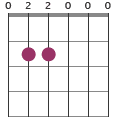
2nd step: Play two chords
There is no need to hurry. After you feel secure strumming one chord, it's time to expand with a second. To make it sound good when playing chords on the guitar, you must be able to move between chords smoothly. Therefore, as a beginner, you should start with chords that are easy to switch between. The following chord, A minor, is quite similar to the E minor shown above.
Try to move between these two chords, but don't stress. Strum slowly and wait several beats before switching to the next chord and do the same until you switch back again.
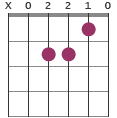
3rd step: Learn other common chords
You may only know these two chords, but you have already adopted the two most fundamental parts of guitar chord playing: rhythmic strumming and switching between chords. The goal is to do it with higher dexterity and with more chords.
When expanding your chord knowledge, a recommendation is to start by looking at some easy open chords and learn the most common. In the end, your motivation will decide how large your stockpile of chords will be and how much your range of techniques to execute them will widen.
For the intermediate guitar player
Learning a new chord is always a good way to improve as a guitar player. Look around on this site and you will find several categories. Besides that, on Guitar-chord.org, you also find articles, guides, lessons and ebooks.